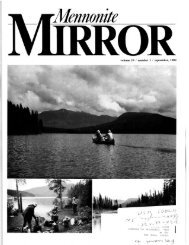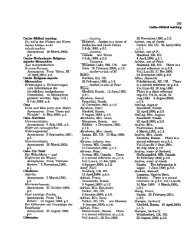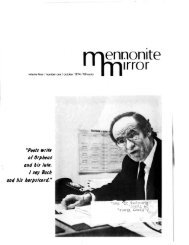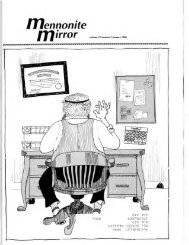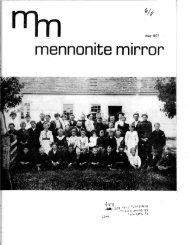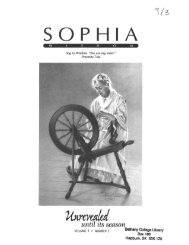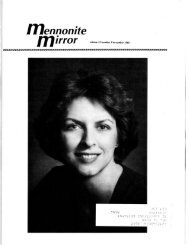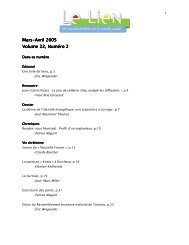• Donwood West opens new retirement option • - Canadian ...
• Donwood West opens new retirement option • - Canadian ...
• Donwood West opens new retirement option • - Canadian ...
You also want an ePaper? Increase the reach of your titles
YUMPU automatically turns print PDFs into web optimized ePapers that Google loves.
and if she could take up chiropractic as a<br />
selVice to her community. He willingly<br />
obliged.<br />
In 1944 she enrolled in a three-year<br />
"Swedish Massage" correspondence<br />
course from the United States. Beginning<br />
with family members, Dueck quickly built<br />
up a clientele in the countryside around<br />
their farm, nine miles southwest of Steinbach.<br />
Soon she was making weekly trips<br />
to Steinbach and Morris to set up clinics.<br />
She even took on some American clients.<br />
When her husband Peter became sick<br />
with cancer, the family moved to Steinbach<br />
and the primary means of income<br />
for the family became Dueck's home<br />
practice. The room was complete with a<br />
home-made chiropractic table, a massage<br />
apparatus which would send a current<br />
through the body, electric vibrators,<br />
and a host of oils, rubbing solutions and<br />
plasters. Treatments throughout her<br />
years of practice cost practically nothing:<br />
two or three dollars a crack, possibly five<br />
in the later years.<br />
Justina Dueck makes claims for her<br />
practice which go far beyond the usual<br />
adjustments for lower back pains and sore<br />
joints. She says she cured one young man<br />
of a stuttering problem by straightening<br />
his neck and massaging his throat. Often<br />
women with child-bearing complications<br />
due to crooked uteruses would come for<br />
treatments. Dueck has also treated people<br />
with bedwetting problems through massage<br />
of the kidney area.<br />
As the son of a medical doctor who is<br />
suspicious of the field, I have to know<br />
what she thinks of the medical profession.<br />
Unlike Yasch Siemens, she does not completely<br />
write doctors off, conceding that<br />
chiropractic does not take care of all ail":"<br />
ments - cancer, for example.<br />
But for the joint and muscle ailments<br />
she has treated, she is not convinced doctors<br />
perform as well as chiropractors. "I<br />
had my fingers, and my fingers k<strong>new</strong> how<br />
to do the job," she recalls. "So schooling<br />
did not necessarily help."<br />
She is even suspicious of the <strong>new</strong> breed<br />
of provincially recognized chiropractors<br />
who are required to spend four years in<br />
training, and who are increasingly being<br />
recognized by the medical community.<br />
"The way chiropractors do it now, they<br />
don't fix everything," she said, charmingly<br />
cocksure. She admits, however, that<br />
she does not know any of the <strong>new</strong> chiropractors<br />
personally.<br />
We closed the intelView with some<br />
Valentine chocolates - and some mystery<br />
lingering in my mind. As I drove back<br />
to Winnipeg, I reflected on how much<br />
times have changed since the heyday of<br />
rural folk health.<br />
Today, Mennonites still go to chiropractors,<br />
but they're more likely to go to<br />
the officially licensed ones, like John<br />
Wiens. Wiens, 33, is one of three or four<br />
chiropractors of Mennonite extraction -<br />
out of Manitoba's hundred or so - who<br />
have trained at the <strong>Canadian</strong> Memorial<br />
Chiropractic College in Toronto, Canada's<br />
only chiropractic training institution. He<br />
works in partnership with a Jewish chiropractor<br />
in Winnipeg.<br />
Wiens, also a science graduate of the<br />
University of Manitoba, says that the<br />
basic principles of chiropractic remain the<br />
same, and the techniques of adjusting<br />
have not Changed immensely over the<br />
years. "The big difference is that we think<br />
we understand a little better what we're<br />
doing," he notes.<br />
The education is particularly important<br />
for recognizing some of the fine complications<br />
which arise through chiropractic<br />
therapy. Another shift is a greater<br />
understanding of the dynamic interactions<br />
between bones and muscles,<br />
whereas in the past chiropractic tended to<br />
focus on the static aspects of the skeletal<br />
structure.<br />
Public confidence in chiropractors<br />
among educated, urban people has<br />
grown considerably since Wiens began<br />
practicing in 1980. When he started,<br />
"people would defy you to do something,"<br />
because they weren't sure what all chiropractors<br />
could do.<br />
Now, about 18 per cent of Manitoba's<br />
population go to see chiropractors each<br />
year. If they see officially licensed chiros,<br />
they receive partial coverage through<br />
their Manitoba Health selVices commission<br />
coverage (up to a certain number of<br />
visits), and full coverage if they are<br />
receiving benefits from Worker's Compensation<br />
Board.<br />
Do Mennonites have special leanings<br />
toward chiropractors, as opposed to medical<br />
professionals, for treatment of their<br />
aches and pains? A one-time associate of<br />
Wiens remarked that he felt Mennonites<br />
were more likely to go to chiropractors<br />
because of historical associations with<br />
"rightmakers. "<br />
On the other hand, far more Mennonites<br />
enter the established medical<br />
professions than chiropractic. Wiens<br />
wonders whether there might be a backlash<br />
against chiropractic among the<br />
younger, more educated Mennonites.<br />
Chiropractic for many of them may hark<br />
back to the rural and the folksy roots<br />
which many Mennonites are striving to<br />
trade in for urban respectability.<br />
Wiens represents a <strong>new</strong> generation<br />
which insists that chiropractic can be reconciled<br />
with science and medicine. The<br />
experience of -a recent middle-aged<br />
patient, as told to this writer, may confirm<br />
this. Several visits to a medical doctor<br />
failed to provide a solution for a painful<br />
back condition. Finally, when the patient<br />
asked the doctor whether there was anything<br />
else he could try, the doctor suggested,<br />
with a tinge of sarcasm, that if rest<br />
didn't cure it he might wish to consult a<br />
chiropractor. Well, rest didn't cure it and<br />
the persistent pain prompted him to<br />
overrule his own skepticism and consult<br />
Dr. Wiens. The latter looked carefully at<br />
his posture, noted a bad alignment on one<br />
side and asked him to lie down. Pressure<br />
was applied to the lower back by very<br />
skillful hands, lasting only a few minutes.<br />
The patient was told that he would have<br />
pain for about two more days, and then it<br />
should be gone. And that is what happened.<br />
More than a year has passed since<br />
the treatment and the pain has not<br />
returned.<br />
Experiences like this may eventually<br />
cause doctors and chiropractors to perceive<br />
each other as partners rather than<br />
as rivals. Modem medicine thrives on<br />
specialization; why not just a little bit<br />
more? mm<br />
Have you ever<br />
moved and<br />
forgotten your<br />
mirrors?<br />
To change your address simply cut out<br />
the mailing label which appears on this<br />
magazine. and affix it to the space below:<br />
and write in your <strong>new</strong> address:<br />
Street ___________ _<br />
CitylTown ________ _<br />
Postal Code ________ _<br />
and then send it to our office:<br />
Mennonite Mirror<br />
207-1317A<br />
Winnipeg R3G OV3<br />
mennonite rnirror/april1988/17



